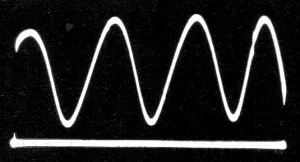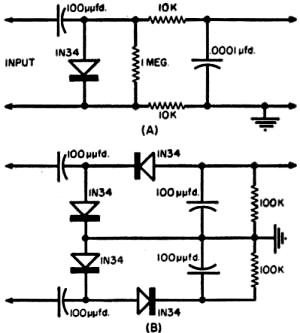|
Measuring voltage standing
wave ratio (VSWR) is a fairly common and simple operation these days with readily
available and relatively inexpensive test equipment. Inserting a power meter
in series with a signal to measuring the incident and reflected power, or even
simpler, inserting a bidirectional power coupler in series with the signal and
measuring the difference between the forward and reverse ports is a routine
matter for even modestly equipped laboratories, Ham shacks, or field operations.
Simply plug the two values into the following equation for the answer:
VSWR=(1 + β)/(1-β), where β=√(Prev/Pfwd). What if
all you have is an oscilloscope, then how would you make the measurement? Actually,
the calculation is even simpler because you use the ratio of the peak incident
and reflected waves, but making the measurement requires more work. This article
presents one way to get the job done.
Comparison Methods for Determining Voltage Standing-Wave Ratios

Fig. 1 - Bench setup showing arrangement of transmission
line for VHF work. Coaxial line is wrapped around box on the left.
By J. F. Sterner
Tube Department, Radio Corporation of America (RCA)
A simple method for matching a load to a transmission line or for determining
if a load is correctly matched.
A combination of high-quality television test equipment such as a sweep generator,
a high-gain oscilloscope, and a demodulator probe or detector provides a quick
and accurate means for matching impedances, determining voltage standing-wave
ratios, and measuring line attenuation. The technique described in this article
is based on the observation and measurement of voltage standing-wave ratios
to determine impedance matches. A good match between a component or circuit
under test and a transmission line results in a VSWR approaching one. If the
VSWR is not close to one, the circuit or component may be replaced by pure resistive
loads having various values until the VSWR obtained with the original setup
is duplicated; the impedance of the component or circuit may then be determined
by direct measurement of the substitute resistive load.

Fig. 2 - Pattern produced by shorted line.

Fig. 3 - Test equipment arrangement for determining
impedance match by VSWR.

Fig. 4 - Simplified block diagram shows the arrangement
of test equipment for matching a transmission line to all antenna.

Fig. 5 - (A) Detector circuit for use with test equipment
shown in Fig. 1. (B) A detector circuit for a balanced input.

Fig. 6 - Oscilloscope pattern produced by a 300-ohm
line terminated by 330·ohm resistor.

Fig. 7 - How a television calibrator is coupled to
the input end of transmission line.

Fig. 8 - Tube loading effect across the antenna circuit
of a TV tuner. The tuner presents a good match to the antenna over the passband
as indicated by the two marks. This is the condition with the filaments turned
on and "B+" applied to the circuit.
The Comparison Method
The complete physical arrangement of a suitable combination of test equipment
is shown in Fig. 3. The output cable of the RCA WR-59C sweep generator
is coupled to one end (input end) of the transmission line. The sweep generator
must have good linearity and a constant output voltage over its frequency range.
The input of an RCA WG-291 demodulator probe or a simple detector is connected
to the same end of the line. The output of the demodulator or detector is fed
to ·the vertical input terminals of the RCA WO-56A oscilloscope. The scope used
in this method must have good linearity and good sensitivity.
If the impedance of the load and the characteristic impedance of the line
are equal, the voltage which appears across the demodulator or detector is independent
of the frequency.1 In other words, if there is a perfect match between
the load and the line, the voltage does not change as the generator sweeps through
its frequency range.
When the load impedance differs from the characteristic impedance of the
line, however, the voltage across the detector or demodulator varies with a
change in frequency. The amplitude of this variation is a function of the reflected
voltage.
If the line is shorted at the output end, highest impedance appears across
the input end of the line at frequencies at which the length of the line is
an odd number of quarter-wavelengths. At these frequencies, therefore, maximum
voltage develops across the demodulator or detector. Lowest impedance and minimum
voltage appear at frequencies at which the line is an even number of quarter-wavelengths.
Fig. 2 shows a typical pattern which may be observed on the oscilloscope.
The number of voltage peaks in the waveform is directly proportional to the
frequency swing of the generator and the length of the line.
This shorted-line method may be used to measure reflected voltage over a
wide range of frequencies, provided that the vertical-amplifier gain control
of the oscilloscope is adjusted initially so that the peak-to-peak amplitude
of the waveform is equal to ten divisions on the screen of the scope. If the
cable is then terminated by a load, the vertical distance between the maximum
and minimum peaks of the waveform represents the reflected voltage. For example,
a waveform having an amplitude of one division represents a reflected voltage
equal to ten percent of the incident voltage over the range of frequencies covered.
Attenuation in the line may also be measured, provided the sweep generator
has blanking of the sweep oscillator so that a zero base line can be observed
on the scope. If there are no losses in the line, the reflected wave equals
the incident wave, and the voltage minimum is coincident with the zero base
line. The distance from the zero base line to the voltage minimum therefore
provides a measure of the attenuation due to losses in the line. Care must be
used in this method to prevent the existence of any large degree of reactance
at the short itself. To make an effective short for 300-ohm line, it is convenient
to strip back the line about one-half inch and twist the leads together. For
coaxial lines, it is better to strip back the inner polyethylene insulation
about one-quarter inch and short the outside braid directly to the inner conductor.
When measurements are made at VHF, the transmission line should be 75 to
100 feet long. 300-ohm line may be wound around a cardboard box, a packing carton,
or any low-dielectric form. The spacing between the turns should be equal to
or greater than the width of the line being used, as shown in Fig. 1. Coaxial
cable may be placed in any convenient location without regard to spacing between
turns.
For most applications in which the frequency is below 216 megacycles, the
detector or demodulator used in the measurements may be an RCA WG-291 demodulator
probe or a simple detector such as that shown in Fig. 5A. An alternate
detector for balanced input is shown in Fig. 5B. Either of these detectors
may be constructed on a phenolic board 1/16-inch thick.
The entire test setup may be checked by the connection of a 1/4-watt or 1/2-watt
carbon resistor, having the same value as the line impedance, directly across
the termination or output end of the line. The line connection to the resistor
leads must be made in the area directly adjacent to the body of the resistor.
The pattern observed on the screen of the oscilloscope should be similar to
that shown in Fig. 6. It may be necessary to try several resistors having
the same nominal value as the line before a good match is obtained because of
variations in the resistance values and in the characteristic impedance of the
line due to manufacturers' tolerances. When a good match has been obtained,
the characteristic impedance of the line may be determined by measurement of
the resistor.
Use of Comparison Method
The application of this method to the determination of impedance matches
can best be illustrated by an example. If it is desired to determine the match
of a 300-ohm transmission line to a television tuner, the tuner is connected
as the load in the arrangement shown in Fig. 3. In this case, because the
effect of the match is limited to a bandwidth of 4.5 megacycles, a television
calibrator such as the RCA WR-39C is used in conjunction with the sweep generator
and the oscilloscope. The calibrator is loosely coupled to the input end of
the line. See Fig. 7.
The sweep generator is set to the same frequency as the television tuner.
Fig. 8 shows typical traces produced on the screen of the scope, representing
a good match and a mismatch, respectively. The efficiency of the match may be
determined from the standing-wave ratio, as follows:
Efficiency = (VSWR-1)/(VSWR+1) where:
VSWR = E2/E1
E2 = peak of reflected wave
E1 = valley of reflected wave
A similar arrangement may be used to determine the transformation ratio of
a matching transformer. The primary of the transformer is connected as the load,
and resistors are substituted across the secondary until a VSWR of unity is
obtained.
This arrangement is also useful in the matching of a transmission line to
an antenna. In the case of a two-element array, for example, the sweep generator
and demodulator are connected to the same end of the line as the receiver or
transmitter, and the antenna is connected as the load. A good match is obtained
by adjustment of the spacing between the two elements of the antenna to give
a VSWR as close to unity as possible. See Fig. 4.
The technique described in this article is simple, and the instruments are
readily available. Accuracy of the method is within ten percent of that obtained
using a slotted-line technique. The engineer or technician willing to spend
the few minutes necessary to set up the equipment will find this method extremely
useful.

Trace with the power removed from the tuner and the reactive
components of the tuner circuit less tube grid loading causing a mismatch.
This shows that the input transformer is properly designed for the type of
tube used in this circuit, i.e., the grid circuit applies a resistive component
across the antenna transformer so as to effect a good match from the 300-ohm
input to the tube.
Reference
1. Bauer, John A.; "Special Applications of Ultra-High-Frequency Wide-Band
Sweep Generators, "RCA Review, Sept. 1947
Posted February 10, 2021
(updated from original post on
9/23/2013
|


















